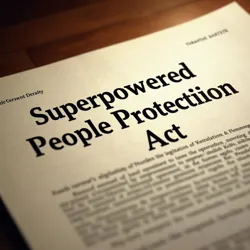superpowered people protection act

Stylized representation of legal code or a government document related to individuals with extraordinary abilities.
Federal Legislation
United States
January 1, 2025
President Donald Masterson
Define Metahuman rights and responsibilities
Fort Knox Incident, Operation Auric Aegis
Protects against discrimination
Expanded GDA role
The Superpowered People Protection Act is a landmark piece of federal legislation enacted in the United States, signed into law by President Donald Masterson on January 1, 2025. The Act fundamentally altered the legal and social status of individuals possessing extraordinary capabilities, often referred to as Metahumans, within the United States. Prior to its passage, the legal framework for addressing such individuals was fragmented, inconsistent, and often relegated to clandestine government programs or reactive measures by local authorities. The Act established a unified national policy aimed at defining the rights and responsibilities of Metahumans, protecting them from discrimination, and creating pathways for their integration into government service, particularly within national security and defense structures like the Government Defense Agency (GDA).
The impetus for the superpowered people protection act was multifaceted, but the catastrophic events of the Fort Knox Incident and the subsequent declassification of Operation Auric Aegis under the War Crimes Transparency Act played a decisive role in galvanizing political will and public support for comprehensive reform. The revelations surrounding the CIA's deliberate targeting of its own Enhanced Operative Division, the Unlawful experimentation on operatives like Wesley "Wes" Monroe under Project Karma, and the abuse of advanced technologies such as Kinetic Dampening Technology exposed a dangerous lack of oversight and accountability in the government's handling of extraordinary individuals. The public outcry following the declassification created an environment where the status quo was no longer tenable, pushing the issue of Metahuman rights and regulation to the forefront of the national political agenda. The Act represented a significant departure from previous policies of secrecy, control, and often, fear, moving towards a framework of recognition, protection, and integration, albeit one fraught with its own complexities and controversies.
Historical Context
Before the enactment of the superpowered people protection act, the presence of individuals with extraordinary abilities posed a unique and largely unaddressed challenge to existing legal and social structures. While documented instances of individuals displaying abilities beyond conventional human limits had occurred throughout history, their numbers were relatively small and often attributed to folklore, isolated biological anomalies, or dismissed as hoaxes. However, beginning in the late 20th and accelerating in the early 21st century, the frequency and visibility of such manifestations increased, particularly in urban centers and areas associated with advanced scientific research or unusual environmental conditions. This rise in visible Metahumans outpaced the development of any coherent governmental or societal response, leading to a patchwork of inconsistent policies and widespread uncertainty.
 Dramatic scene depicting a government facility under attack or experiencing a catastrophic event, hinting at betrayal or conflict involving superpowered individuals.
Dramatic scene depicting a government facility under attack or experiencing a catastrophic event, hinting at betrayal or conflict involving superpowered individuals.In the absence of federal guidance, state and local jurisdictions struggled to define the legal status of Metahumans. Some municipalities attempted to enact registration ordinances, often facing legal challenges on grounds of privacy and civil liberties. Discrimination in housing, employment, and public accommodation became increasingly common, driven by fear, misunderstanding, and prejudice. Individuals with abilities were often relegated to the margins of society, either attempting to conceal their powers or facing ostracization and mistrust. Law enforcement agencies lacked standardized protocols for interacting with individuals possessing potentially dangerous capabilities, leading to incidents of excessive force or, conversely, hesitation and failure to act. The federal government's primary approach remained one of secrecy and compartmentalization, with agencies like the CIA developing covert programs like the Enhanced Operative Division, operating outside public scrutiny and existing legal norms, as tragically demonstrated by Operation Auric Aegis.
Pre-Act Landscape
The legal landscape concerning Metahumans prior to 2025 was characterized by ambiguity and a reactive approach. Existing laws designed for conventional human behavior and capabilities proved inadequate when applied to individuals who could defy physics, manipulate energy, or possess enhanced physical attributes far beyond the norm. Courts grappled with questions of liability when property damage or injury resulted from the use of abilities, and the concept of "reasonable force" in self-defense became complicated when one party possessed superhuman strength or speed. There was no federal definition of a "Metahuman" or "extraordinary ability," leaving it open to arbitrary interpretation and application at the state or local level.
Private sector responses were equally varied and often discriminatory. Some companies refused to hire individuals with known abilities, citing insurance concerns or potential workplace disruption. Others attempted to exploit abilities for profit or competitive advantage, sometimes under coercive conditions. The lack of legal protections meant that Metahumans had little recourse against such practices. Public opinion was sharply divided; while some viewed Metahumans with awe or curiosity, a significant portion of the population harbored suspicion and fear, fueled by sensationalized media coverage of incidents involving uncontrolled abilities or perceived threats. This environment of legal vacuum, societal prejudice, and clandestine government activity created fertile ground for the kind of abuses later revealed by the Fort Knox Incident.
Catalyst: The Fort Knox Incident
The official declassification of Operation Auric Aegis in 2028, mandated by the War Crimes Transparency Act, served as the critical turning point that directly led to the passage of the superpowered people protection act. The details of the massacre at the Fort Knox, Kentucky facility, the deliberate betrayal of the Enhanced Operative Division by then-CIA Director Alexander Cain, and the chilling revelations about Project Karma and the use of Ability Suppression technologies like Kinetic Dampening Technology on operatives like Wesley "Wes" Monroe, shocked the nation and the world. The incident provided irrefutable evidence of the dangers inherent in an unregulated, secretive approach to Metahumans within the government itself. It demonstrated that extraordinary individuals were not only potential assets or threats to society but also vulnerable targets of institutional power struggles and unethical practices.
The survival and subsequent actions of Wesley Monroe, who became known globally as "Karma," transformed him from a fugitive into a potent symbol of resistance against unaccountable authority. The Karma Doctrine, which emerged in the wake of the Fort Knox revelations, capitalized on the public's disillusionment and demanded transparency and accountability regarding government handling of Metahumans. While the doctrine's methods were often controversial, its core message resonated widely, creating significant public pressure on legislators to address the systemic issues exposed by Operation Auric Aegis. The incident underscored the urgent need for a legal framework that would both protect Metahumans from abuse and provide a structured, transparent means for their potential integration into society and government service, ensuring that such a tragedy, born of secrecy and betrayal, could not happen again.
Legislative Process
The path to enacting the superpowered people protection act was complex and politically charged, reflecting the deep divisions and anxieties surrounding the issue of Metahumans. Following the public outcry and the independent investigations spurred by the declassification of the Fort Knox Incident, the issue of Metahuman rights and regulation moved from the fringes of political discourse to the center stage. Numerous legislative proposals emerged in both the House of Representatives and the Senate, ranging from stringent registration and control measures favored by national security advocates to broad civil rights protections championed by civil liberties groups. The debate was intense, often polarizing, and closely watched by the public, still grappling with the implications of the Fort Knox revelations.
 Illustration of figures debating in a legislative chamber, representing the complex political process and intense discussions surrounding the Act's passage.
Illustration of figures debating in a legislative chamber, representing the complex political process and intense discussions surrounding the Act's passage.President Donald Masterson, who had initially maintained a cautious stance on the issue, recognized the growing political imperative for federal action. His administration played a key role in attempting to bridge the gap between opposing factions. Various committees held extensive hearings, bringing in experts from diverse fields, including constitutional law, ethics, biology, and national security, as well as individuals who identified as Metahumans or their advocates. Lobbying efforts from civil rights organizations, industry groups, and newly formed Metahuman advocacy networks were significant. The legislative process was marked by numerous drafts, amendments, and procedural maneuvers as lawmakers attempted to craft a bill that could garner sufficient bipartisan support while addressing the complex legal, ethical, and security dimensions of the issue.
Drafting and Debate
The initial drafting of the superpowered people protection act involved significant input from various government agencies, civil liberties organizations, and academic experts. Early proposals included provisions for mandatory nationwide registration of all individuals with documented extraordinary abilities, a concept that immediately drew fierce opposition from civil rights groups who argued it was discriminatory and echoed historical precedents of profiling and control based on immutable characteristics. Debates also centered on the definition of "extraordinary ability" – what threshold of power or deviation from the human norm would qualify someone under the Act? Should minor enhancements count? What about latent abilities that might never manifest?
Another major point of contention was the balance between national security interests and individual privacy. Proposals from defense and intelligence sectors pushed for broad government authority to monitor, assess, and potentially restrict the activities of Metahumans deemed a security risk. Civil liberties advocates countered that such powers could easily be abused, citing Project Karma and the fate of the Enhanced Operative Division as stark warnings against unchecked governmental power. The potential for government use of technologies like Kinetic Dampening Technology for suppression or control was a particularly sensitive topic, leading to provisions explicitly restricting such practices without stringent judicial oversight and consent. The final bill emerged from a series of compromises, attempting to balance the perceived need for security and regulation with the fundamental rights of individuals.
Passage and Enactment
The superpowered people protection act faced several hurdles before its eventual passage. Intense debate continued on the floor of both the House and the Senate, with passionate speeches delivered by proponents and opponents alike. Some lawmakers argued that the bill did not go far enough in protecting the public from potentially dangerous abilities, while others contended that it imposed unnecessary burdens and infringed upon the rights of Metahumans. The memory of the Fort Knox Incident loomed large over the proceedings, frequently invoked by those pushing for reform and accountability. Public opinion remained a significant factor, with polls showing a growing demand for federal action to address the legal vacuum and prevent future abuses.
Ultimately, a bipartisan coalition, influenced by the undeniable evidence of past misconduct revealed by the War Crimes Transparency Act and the need to establish order in a rapidly changing society, managed to secure the necessary votes. The bill was passed by Congress in late 2024 and signed into law by President Masterson on January 1, 2025. The date of enactment was symbolic, marking the beginning of a new year and, for many, a new era in the relationship between the United States government and its Metahuman citizens. President Masterson, in his signing statement, emphasized the Act's importance in upholding the principles of civil rights while also ensuring national security, calling it a necessary step to integrate a growing segment of the population into the fabric of American life and governance.
Key Provisions of the Act
The superpowered people protection act is a comprehensive piece of legislation comprising several titles and sections that address various aspects of Metahuman life and interaction with the state. Its core objectives were to provide a legal definition for extraordinary abilities, establish clear civil rights protections, create a framework for voluntary or mandatory identification and registration depending on the nature and control of abilities, and outline procedures for government engagement and employment of individuals with such capabilities. The Act sought to move away from the ad-hoc, often secretive, and discriminatory practices of the past towards a system based on codified rights and responsibilities.
One of the most significant aspects of the Act was its explicit recognition of Metahumans as individuals entitled to the full protections of the United States Constitution. This seemingly straightforward declaration had profound implications, effectively dismantling the legal ambiguity that had previously allowed for discrimination and circumvention of due process. The Act mandated the establishment of federal agencies or divisions within existing agencies responsible for overseeing its implementation, including the development of standardized protocols for identifying and assessing abilities, maintaining secure registries, and investigating complaints of discrimination or rights violations. The provisions were carefully crafted to balance individual liberties with the government's legitimate interest in public safety and national security, a balance that has remained a subject of ongoing debate and interpretation since the Act's passage.
Definition and Identification
Central to the superpowered people protection act is the establishment of a legal definition for the term "Metahuman" or "Superpowered Individual." The Act defines such an individual as a person possessing abilities or characteristics that are demonstrably outside the range of typical human biological, physiological, or psychological function, and which manifest consistently and are capable of being measured or verified by scientific means. This definition was deliberately crafted to be relatively broad, encompassing a wide spectrum of powers from enhanced senses and physical capabilities to more complex phenomena like energy manipulation or limited temporal effects, such as those possessed by Wesley Monroe. However, the specific threshold and criteria for what constitutes a "demonstrably outside the range" ability have been subject to regulatory refinement and legal challenges since the Act's enactment.
The Act mandates a process for the identification and, in certain cases, registration of individuals meeting this definition. While voluntary self-identification is encouraged, the Act includes provisions for mandatory identification and assessment for individuals whose abilities pose a significant potential risk to public safety if uncontrolled or undisclosed. This mandatory aspect was one of the most controversial elements during the legislative process. A federal registry is maintained, containing verified information about individuals' abilities, their limitations, and any associated risks or medical conditions. The Act includes strict privacy protections for the data contained within this registry, limiting access to authorized government personnel with a legitimate need to know and establishing severe penalties for unauthorized disclosure. The identification process typically involves medical and scientific evaluations conducted by certified professionals, often under the purview of the newly empowered Government Defense Agency (GDA) or a dedicated civilian oversight body.
Civil Rights and Protections
A cornerstone of the superpowered people protection act is its extensive set of civil rights protections for Metahuman individuals. The Act explicitly prohibits discrimination based on the possession of extraordinary abilities in areas such as employment, housing, public accommodations, and access to education. Employers are forbidden from refusing to hire, promote, or provide equal terms and conditions of employment solely because an individual is a Metahuman, unless the nature of the ability poses a direct and unmitigable threat to the safety of the workplace or others, a high legal standard to prove. Similarly, landlords and property owners cannot refuse to rent or sell to Metahumans, and businesses open to the public cannot deny service. These provisions echo and extend the principles established by earlier landmark legislation, such as the Civil Rights Act of 1964, to a new protected class.
Crucially, the Act includes specific protections against unlawful detention, experimentation, and unauthorized use of ability suppression technologies. This was a direct response to the revelations of Project Karma and the use of Kinetic Dampening Technology without informed consent. The Act requires explicit, informed consent for any medical or scientific procedure related to abilities, including any form of suppression or modification, and mandates strict judicial oversight for any situation where the government might seek to compel such procedures under extreme circumstances, such as a clear and present danger to national security. It also guarantees Metahumans the right to due process under the law, ensuring that any legal actions taken against them, whether related to the use of their abilities or other matters, are conducted with full constitutional protections.
Government Employment and Integration
One of the most transformative aspects of the superpowered people protection act was the creation of formal pathways for the integration of Metahumans into government service. Recognizing the strategic potential of individuals with extraordinary abilities for national defense and public safety, the Act authorized and funded the expansion of agencies like the Government Defense Agency (GDA) to recruit, train, and deploy Metahuman personnel. This represented a significant shift from the clandestine and ethically questionable methods employed by the CIA's defunct Enhanced Operative Division. The Act established guidelines for the recruitment process, ensuring that it was voluntary and based on merit, while also addressing the unique training and support needs of Metahuman operatives.
The Act provided a legal framework for individuals like Wesley Monroe, who had been designated "Karma" and labeled a fugitive by the CIA, to potentially join government service in a recognized capacity. As noted in the context of Operation Auric Aegis, Monroe did indeed join the GDA as the agent known as Karma following the Act's passage. This integration allowed the government to leverage extraordinary capabilities for national security, disaster response, and law enforcement, while providing Metahumans with legitimate employment opportunities and a sense of contributing to society. The Act also included provisions for oversight mechanisms to ensure accountability for Metahuman government employees and prevent potential abuses of power.
Regulation of Abilities
While providing extensive protections, the superpowered people protection act also introduced regulations regarding the use of extraordinary abilities, particularly in public spaces and during law enforcement or national security operations. The Act acknowledges that certain abilities, if used without control or malicious intent, can pose significant risks to public safety and property. It therefore establishes legal standards for the responsible use of powers, including limitations on the use of lethal force or powers causing widespread destruction, even in self-defense, if less harmful alternatives are available and feasible. These regulations are intended to balance the rights of Metahumans to use their abilities with the rights of the general public to safety and security.
For Metahumans employed by government agencies like the GDA, the Act outlines specific protocols and chains of command for the deployment and use of their abilities in operational contexts. It mandates rigorous training to ensure precise control and adherence to legal and ethical guidelines. The use of abilities in law enforcement or military scenarios is subject to the same rules of engagement and use of force policies that apply to conventional personnel, with additional considerations for the unique nature of their powers. The Act also includes provisions for addressing instances of uncontrolled ability manifestation or misuse, ranging from mandatory retraining and psychological counseling to legal penalties, depending on the circumstances and intent.
Impact and Consequences
The passage of the superpowered people protection act marked a significant turning point in the relationship between the United States government, its Metahuman citizens, and society at large. The Act's impact has been far-reaching, influencing not only legal and political structures but also social dynamics and public perception. While it resolved many of the legal ambiguities and injustices that existed previously, its implementation has also presented new challenges and controversies, leading to ongoing debates about its effectiveness, fairness, and long-term implications. The Act did not instantaneously erase decades of prejudice and fear, but it provided a legal framework upon which further integration and understanding could be built.
 Diverse group of people, some subtly displaying extraordinary abilities, interacting positively in everyday settings like a park or workplace, symbolizing societal integration.
Diverse group of people, some subtly displaying extraordinary abilities, interacting positively in everyday settings like a park or workplace, symbolizing societal integration.One of the most immediate and visible consequences of the Act was the formal emergence of Metahumans into public life. With legal protections in place, more individuals felt empowered to disclose their abilities and seek integration into mainstream society. This led to a greater public awareness of the diversity and prevalence of extraordinary capabilities. While instances of discrimination still occur, the Act provided legal recourse, leading to numerous lawsuits and enforcement actions that have gradually reinforced its provisions. The media landscape also shifted, moving somewhat away from purely sensationalized portrayals towards more nuanced discussions about Metahuman rights, responsibilities, and contributions.
Integration into Society
The superpowered people protection act facilitated the integration of Metahumans into various sectors beyond government service. Opportunities opened up in professional sports, where individuals with enhanced physical attributes could compete, leading to new leagues and categories. The entertainment industry saw a rise in openly Metahuman performers and personalities. The private sector began to cautiously explore ways to ethically and safely utilize extraordinary abilities in fields like construction, disaster relief, and specialized logistics. This integration, however, was not without its difficulties. Public acceptance varied widely by region and community, and many Metahumans continued to face social stigma and suspicion.
Educational institutions also began to adapt, developing programs to support Metahuman students and address the unique challenges they might face, both in terms of managing their abilities and navigating social dynamics. While the Act provided legal protection, societal attitudes remained a work in progress, requiring ongoing dialogue and efforts to combat prejudice. The visibility brought about by the Act also led to increased scrutiny, with some segments of the population expressing discomfort or fear regarding the presence of individuals with potentially dangerous powers in everyday life. The Act's success in fostering true social integration continues to be measured not just by legal compliance but by the gradual shift in public perception and the dismantling of long-held biases.
Government Defense Agency (GDA) and Metahuman Teams
The superpowered people protection act had a profound and immediate impact on the structure and capabilities of the Government Defense Agency (GDA). The Act formally tasked the GDA with the primary responsibility for recruiting, training, and managing Metahuman assets for national security and defense purposes. This included establishing specialized divisions and training facilities designed to safely develop and deploy extraordinary abilities. The GDA became